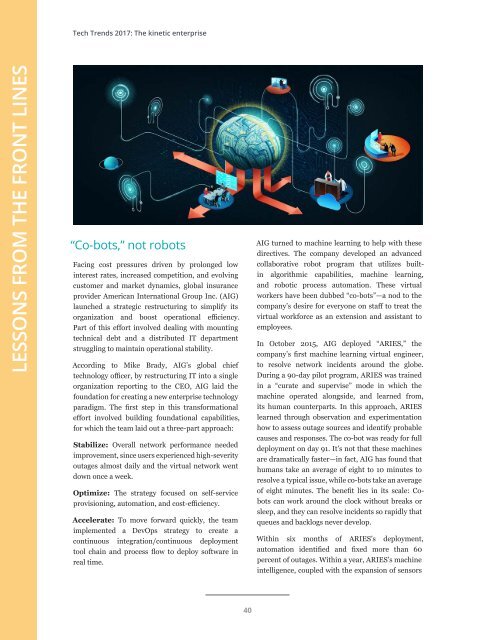Trending the trends Eight years of research
2kcf8xh
2kcf8xh
You also want an ePaper? Increase the reach of your titles
YUMPU automatically turns print PDFs into web optimized ePapers that Google loves.
Tech Trends 2017: The kinetic enterprise<br />
LESSONS FROM THE FRONT LINES<br />
“Co-bots,” not robots<br />
Facing cost pressures driven by prolonged low<br />
interest rates, increased competition, and evolving<br />
customer and market dynamics, global insurance<br />
provider American International Group Inc. (AIG)<br />
launched a strategic restructuring to simplify its<br />
organization and boost operational efficiency.<br />
Part <strong>of</strong> this effort involved dealing with mounting<br />
technical debt and a distributed IT department<br />
struggling to maintain operational stability.<br />
According to Mike Brady, AIG’s global chief<br />
technology <strong>of</strong>ficer, by restructuring IT into a single<br />
organization reporting to <strong>the</strong> CEO, AIG laid <strong>the</strong><br />
foundation for creating a new enterprise technology<br />
paradigm. The first step in this transformational<br />
effort involved building foundational capabilities,<br />
for which <strong>the</strong> team laid out a three-part approach:<br />
Stabilize: Overall network performance needed<br />
improvement, since users experienced high-severity<br />
outages almost daily and <strong>the</strong> virtual network went<br />
down once a week.<br />
Optimize: The strategy focused on self-service<br />
provisioning, automation, and cost-efficiency.<br />
Accelerate: To move forward quickly, <strong>the</strong> team<br />
implemented a DevOps strategy to create a<br />
continuous integration/continuous deployment<br />
tool chain and process flow to deploy s<strong>of</strong>tware in<br />
real time.<br />
AIG turned to machine learning to help with <strong>the</strong>se<br />
directives. The company developed an advanced<br />
collaborative robot program that utilizes builtin<br />
algorithmic capabilities, machine learning,<br />
and robotic process automation. These virtual<br />
workers have been dubbed “co-bots”—a nod to <strong>the</strong><br />
company’s desire for everyone on staff to treat <strong>the</strong><br />
virtual workforce as an extension and assistant to<br />
employees.<br />
In October 2015, AIG deployed “ARIES,” <strong>the</strong><br />
company’s first machine learning virtual engineer,<br />
to resolve network incidents around <strong>the</strong> globe.<br />
During a 90-day pilot program, ARIES was trained<br />
in a “curate and supervise” mode in which <strong>the</strong><br />
machine operated alongside, and learned from,<br />
its human counterparts. In this approach, ARIES<br />
learned through observation and experimentation<br />
how to assess outage sources and identify probable<br />
causes and responses. The co-bot was ready for full<br />
deployment on day 91. It’s not that <strong>the</strong>se machines<br />
are dramatically faster—in fact, AIG has found that<br />
humans take an average <strong>of</strong> eight to 10 minutes to<br />
resolve a typical issue, while co-bots take an average<br />
<strong>of</strong> eight minutes. The benefit lies in its scale: Cobots<br />
can work around <strong>the</strong> clock without breaks or<br />
sleep, and <strong>the</strong>y can resolve incidents so rapidly that<br />
queues and backlogs never develop.<br />
Within six months <strong>of</strong> ARIES’s deployment,<br />
automation identified and fixed more than 60<br />
percent <strong>of</strong> outages. Within a year, ARIES’s machine<br />
intelligence, coupled with <strong>the</strong> expansion <strong>of</strong> sensors<br />
40


